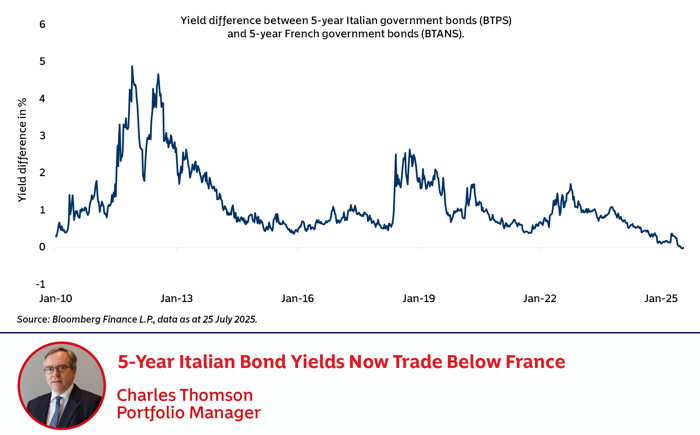
What this chart shows
This chart shows the yield difference between 5-year Italian government bonds (BTPS) and 5-year French government bonds (BTANS).
Why this is important
2025 marks the 100 year anniversary since Italy last ran a budget surplus! Unsurprisingly Italy’s national debt as a percentage of GDP is very high. GDP growth has been weak and this, along with persistently unstable politics has meant that Italian bonds yields have generally been substantially higher than those of France. In 2011 this yield difference was 500 basis points! Italy’s credit rating is also substantially lower: Moody’s rates France Aa3 and Italy Baa3, some six notches lower.
So what has changed? On public finances, Italy’s debt to GDP has declined from 158% of GDP during covid to 135% now. French debt has increased to 121% of GDP. Also, significantly, Italy has persistently run primary budget surpluses (i.e. before debt interest) while France has consistently run primary deficits. Italian government debt is mainly held domestically which provides a degree of protection missing in France. Politics in Italy appears to be improving markedly – the same cannot be said for France.
Global markets rallied early on trade leniency before capitulating on US economic weakness and tariff uncertainty - marking the fraught tone for emerging market sentiment.

-
Donald Trump set a 10% minimum global tariff, while imports from countries with trade surpluses with the US will face duties of 15% or higher. Levies on Canadian imports will be increased to 35%, but USMCA goods remain exempt.
-
A similar US - Japan trade accord capped tariffs at 15% (down from 25–27.5%), tied to a Japanese $550 billion investment commitment in US industries.
-
US job growth disappointed in July (only ~73K payrolls added), triggering a 1.6% drop in the S&P 500 and over 2% decline ‑in the Nasdaq, raising expectations of Fed rate cuts.
-
Drugmakers including Eli Lilly and Novo were sent letters from Trump, who demanded they cut US prices to match foreign rates, giving them 60 days to comply or face consequences.

-
The Bank of England faces rising inflation (~3.6% in June) and is expected to deliver a fifth consecutive rate cut amid stagflation concerns.
-
British exports to India could surge thanks to a newly finalised UK-India trade deal reducing tariffs across most goods.
-
The UK’s FCA will consult banks on a redress scheme for mis-sold car loans that may cost at least £9 billion.
-
European spillovers from US tariff policy heightened uncertainty over UK manufacturing and trade competitiveness.

-
The Swiss franc dipped after Switzerland was slapped with a 39% tariff by the US.
-
European markets were cautious, the euro weakened 1–1.3% as investors worried the deal favoured the US and could hamper EU growth.
-
ECB held interest rates steady at its July meeting after seven straight cuts, citing uncertainty around trade policy and workload risks.
-
Luxury brands in Europe (like LVMH and Prada) reported declining Q2 sales amid weaker tourist spending and currency swings.

-
China’s exporters are rethinking the “China plus one” diversification strategy as US tariff changes reduce incentives to shift production to Southeast Asia.
-
At the China AI industry show (July 28), Beijing laid out an open‑source, globally cooperative AI strategy in direct contrast to US “America First” rhetoric.
-
Markets surged after the US-Japan trade deal, with the Nikkei up ~4.2%, led by major auto stocks like Toyota and Subaru jumping 11-13%; Hang Seng also rallied.
-
Copper fluctuated on the LME and slumped on the Comex after Donald Trump unexpectedly exempted refined metal from US import tariffs.
